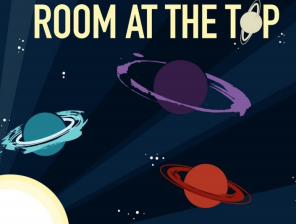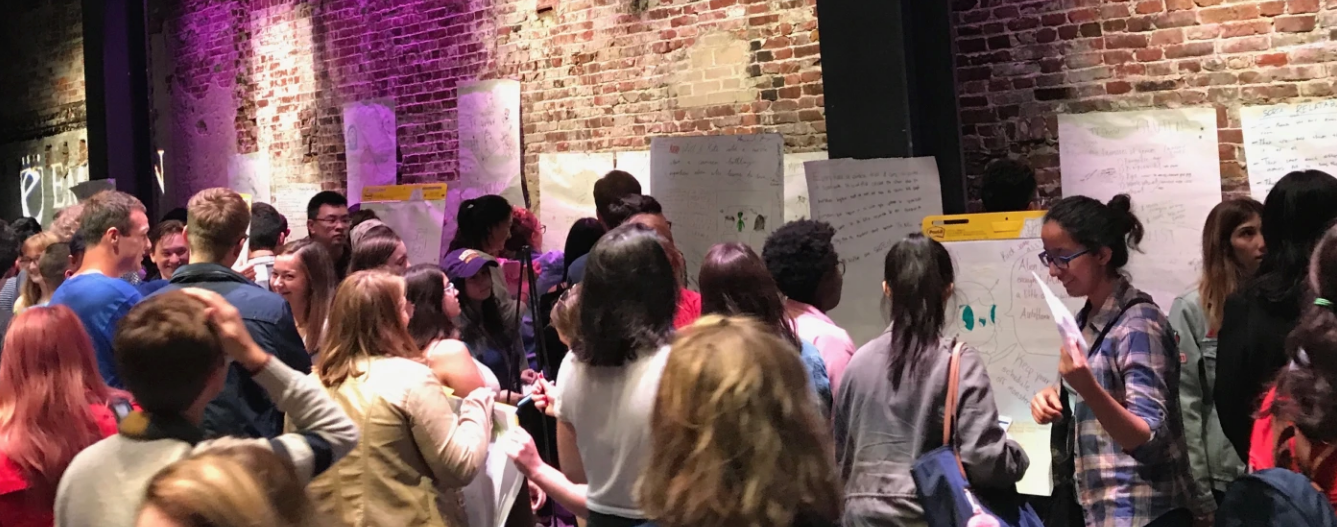Room at the Top is a multiplayer live card game that teaches players to recognize their own implicit bias, challenge assumptions about power in teamwork, and encourage the formation and cultivation of diverse teams. The game is designed by Emerson College’s Miranda Banks, Associate Professor, and Northeastern University’s Sam Liberty, Part-Time Lecturer – and challenges players (can be anywhere from 12-120 people) to take on the role of interplanetary media-makers and compete both as individuals and groups to win the top prize in an intergalactic media festival. Based on extensive research about power, labor, behavior, and bias, the game encourages creative collaboration, heightens self-awareness, and challenges ‘traditional’ ways of working together. This fall, students at Northeastern will have the opportunity to experience the game first-hand. Through a Faculty Innovation Grant from Northeastern University’s Office of Institutional Diversity and Inclusion (OIDI) in partnership with the Center for Advancing Teaching and Learning Through Research (CATLR), Room at the Top will be piloted as part of Northeastern’s orientation programming for Game Design undergraduate students. The grant was awarded to the designers along with CAMD game faculty member Celia Pearce, who also has extensive experience in both researching and designing for inclusion.

Room at the Top was incubated at the Emerson Engagement Lab, an applied research and design lab dedicated to reimagining civic engagement for a mediated culture. Originally designed to address disparities in the film industry, it is based off of years of extensive research with media professionals and young people on the ways biases disrupt and hinder creative collaboration.
“The bias dynamics that I research in media production in Hollywood are similar to what’s happening across many other industries, and are comparable to the experience of college students,” Dr. Banks, whose primary research areas are the American film and television industries, said. “I would see women more often going into certain aspects of the field or taking specific production roles, and men taking others, trends I believe faculty and students should remember to question. Everybody needs to be aware of assumptions we are making about who is a good candidate for which jobs or roles.”
To create Room at the Top, the research included interviews, focus groups, and surveys. The surveys were unique and deliberate; rather than having them be directly about racism or bias, they started by asking participants about their vision and mindset for their own careers, what success looked like for them, and their aims for collaboration.
“One question was ‘if you could have anyone’s career, whose would you want?’ and all respondents, no matter their race or gender were inclined to name the careers of white men. These, among others, were powerful answers to me,” said Dr. Banks. “Another question was ‘have you ever felt discriminated against or witnessed discrimination happening to someone else?’ Some of the responses to this prompt were, as you may imagine, a punch in the gut.”
The survey results indicated that people had a hard time speaking and standing up against discrimination – both when it was happening to them and when it was happening to others.
“In my research I found a lot of people have observed discrimination against others but do not know what to do with it,” added Northeastern’s Celia Pearce, Associate Professor, who played a key role in bringing Room at the Top to campus. “We need to empower everyone to speak out, including allies.”
The research behind Room at the Top explored and focused on the concept of homophily, the tendency of individuals to associate and bond with those who are similar to themselves. Banks’ research found a high tendency towards homophily, an instinct to work with friends or people who are “just like me.” The goals of Room at the Top are to increase awareness and sensitivity around homophily (and shine a light on the rewards that come from working with people who are different), while also facilitating conversations about, and ultimately increasing, diversity.

Over the course of the game, players hailing from four different planets are challenged to collaborate to create the best creative work (in order to get accepted into the Intergalactic media arts festival), but must pit their individual goals against that of the group. These goals are designed to highlight real-world biases, so players are motivated to work with people similar to themselves (from the same planet, visual sameness, etc.) to achieve a personal victory. Also like the real-world, some players are more powerful than others, based off their assigned role – musician, producer, director, editor, cinematographer, actor, writer, etc. This level of power is represented by an influence number at the bottom of each card; the higher the number, the more likely the role has the ability to actually develop and build the project. Players must balance power and influence, personalities, and creative output to win.
“My hope is that people walk away from the game with a sense of awareness about the choices they are making as collaborators as well as the way that they behave as collaborators,” said Dr. Banks. “Players will gain a heightened awareness of the whole collaboration experience, and check some of the ‘traditional’ ways of doing things.”
By the end of the game, players have created a large visual poster – and have the opportunity to participate in rich facilitated conversations about competition, inclusion, power, team-building, community, bias, and the creative process. Room at the Top builds the foundation for self-reflection and provides a safe space for this important communication to take place. In fact, creating this safe space was the primary reason Dr. Banks decided to build a game—rather than use other media—to address these extremely emotionally and politically charged topics. Individuals from under-represented or minority groups do not need to be told that they deserve a chance, and people who do have privilege often get defensive before the conversation can even start. A game, however, especially one that takes place in another universe, creates a safe distance for experimentation.
“I wanted to simulate the experience of making — people behave differently when they are doing something instead of talking about doing something,” said Dr. Banks. “I also wanted people to approach the topics of bias and collaboration from a different perspective; I liked the role-playing idea. So I asked, ‘how do we create an experience in the room where everyone gets to challenge their own perceptions and engage in something that goes beyond a lecture?’”
Creating this distance was an important theme that came to light when Professors Banks and Liberty brainstormed with their colleagues, other faculty members, and diversity specialists during the game’s formation.
Added Liberty: “These conversations revealed that it was important not be too one to one with the real world. The experts recommended some element of fantasy, some fiction to make it more comfortable. We landed on the idea of placing it on outer space. It’s generic enough to be non-offensive – there is no representation of people at all. It’s simply about what planet you’re from.”
Room at the Top is relevant for adults of all ages, but it is especially valuable for college-aged students. Young people are still forming their habits, and students today are showing a genuine willingness to learn and do better through self-reflection. This game is an opportunity to build their teamwork and collaboration skills before they enter their respective industries.
“The collaboration skills that students learn in college are some of the most important skills they learn,” Dr. Pearce said. “In any job, you need to be able to interact with your colleagues and have strong interpersonal communication skills. In a field like game design, this becomes even more important; you could be spending 80 hours with your team in the same room. You want to be able to work effectively with the people around you.”
As college professors, Banks, Liberty, and Pearce all emphasize they are in positions to ignite change. Their teaching is an effective avenue for impacting perceptions and forming ideas about what it means to be a leader. Room at the Top is a tool they can use to support and emphasize some of the themes they are already weaving into their classrooms.
“It can be hard to change people’s behavior, but this game is an opportunity to raise awareness about biases, racism, sexism, class, ability, and more,” said Dr. Banks. Added Dr. Pearce: “These are social problems and they need social solutions.”
“People can start thinking about who they work with as a deliberate choice,” added Liberty. “Most people don’t deliberately work with individuals who are different than them. This game is an opportunity to challenge people, moving forward, to deliberately choose to do so.”
While the game is set in the context of a media festival, it could easily change from industry to industry, making it very flexible and applicable. In the future, other creative fields could be mapped into it, representing anything from game designers to a symphony orchestra.
We look forward to incorporating Room at the Top into Northeastern’s orientation. It will be sure to excite, inform, and engage new Game Design students joining Northeastern, and if the project goes well, could expand to the greater CAMD community.


